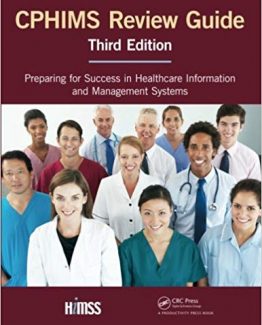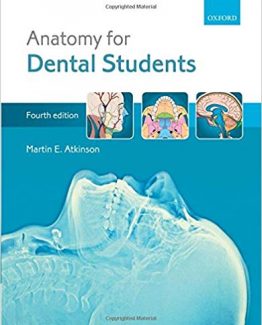Rodak’s Hematology: Clinical Principles and Applications 6th Edition by Elaine M. Keohane, ISBN-13: 978-0323530453
[PDF eBook eTextbook]
- Publisher: Saunders; 6th edition (March 25, 2019)
- Language: English
- 904 pages
- ISBN-10: 0323530451
- ISBN-13: 978-0323530453
Make sure you are thoroughly prepared to work in a clinical lab. Rodak’s Hematology: Clinical Principles and Applications, 6th Edition uses hundreds of full-color photomicrographs to help you understand the essentials of hematology. This new edition shows how to accurately identify cells, simplifies hemostasis and thrombosis concepts, and covers normal hematopoiesis through diseases of erythroid, myeloid, lymphoid, and megakaryocytic origins. Easy to follow and understand, this book also covers key topics including: working in a hematology lab; complementary testing areas such as flow cytometry, cytogenetics, and molecular diagnostics; the parts and functions of the cell; and laboratory testing of blood cells and body fluid cells.
- UPDATED nearly 700 full-color illustrations and photomicrographs make it easier for you to visualize hematology concepts and show what you’ll encounter in the lab, with images appearing near their mentions in the text to minimize flipping pages back and forth.
- UPDATED content throughout text reflects latest information on hematology.
- Instructions for lab procedures include sources of possible errors along with comments.
- Hematology instruments are described, compared, and contrasted.
- Case studies in each chapter provide opportunities to apply hematology concepts to real-life scenarios.
- Hematology/hemostasis reference ranges are listed on the inside front and back covers for quick reference.
- A bulleted summary makes it easy for you to review the important points in every chapter.
- Learning objectives begin each chapter and indicate what you should achieve, with review questions appearing at the end.
- A glossary of key terms makes it easy to find and learn definitions.
- NEW! Additional content on cell structure and receptors helps you learn to identify these organisms.
- NEW! New chapter on Introduction to Hematology Malignancies provides and overview of diagnostic technology and techniques used in the lab.
Table of Contents:
Cover image
Title page
Table of Contents
Inside front cover
Copyright
Tribute
Dedication
Reviewers
Contributors
Preface
PART 1. Introduction to Hematology
1. An overview of clinical laboratory hematology
References
2. Quality assurance in hematology and hemostasis testing
References
PART 2. Blood Cell Production, Structure, and Function
3. Cellular structure and function
References
4. Hematopoiesis
References
5. Erythrocyte production and destruction
References
6. Erythrocyte metabolism and membrane structure and function
References
7. Hemoglobin metabolism
References
8. Iron kinetics and laboratory assessment
References
9. Leukocyte development, kinetics, and functions
References
10. Platelet production, structure, and function
References
PART 3. Laboratory Evaluation of Blood Cells
11. Manual, semiautomated, and point-of-care testing in hematology
Procedure
Procedure
Procedure
Procedure
Procedure
Procedure
Procedure
Additional resources
References
12. Automated blood cell analysis
References
13. Examination of the peripheral blood film and correlation with the complete blood count
References
14. Bone marrow examination
References
15. Body fluid analysis in the hematology laboratory
Performing cell counts on body fluids
Performing differential cell counts on body fluids
Cerebrospinal fluid
Serous fluid
Synovial fluid
Bronchoalveolar lavage specimens
Summary
Review questions
References
PART 4. Erythrocyte Disorders
16. Anemias: Red blood cell morphology and approach to diagnosis
References
17. Disorders of iron kinetics and heme metabolism
References
18. Anemias caused by defects of DNA metabolism
References
19. Bone marrow failure
References
20. Introduction to increased destruction of erythrocytes
References
21. Intrinsic defects leading to increased erythrocyte destruction
References
22. Extrinsic defects leading to increased erythrocyte destruction—nonimmune causes
References
23. Extrinsic defects leading to increased erythrocyte destruction—immune causes
References
24. Hemoglobinopathies (structural defects in hemoglobin)
References
25. Thalassemias
References
PART 5. Leukocyte Disorders
26. Nonmalignant leukocyte disorders
References
27. Introduction to hematologic neoplasms
References
28. Flow cytometric analysis in hematologic disorders
References
29. Molecular diagnostics in hematopathology
References
30. Cytogenetics/cytogenomics
References
31. Acute leukemias
References
32. Myeloproliferative neoplasms
References
33. Myelodysplastic syndromes
References
34. Mature lymphoid neoplasms
Immunologic diversity
Classification schemas based on cell differentiation
Approach to diagnosis: Interface between clinical and laboratory medicine
Leukemias
Lymphomas
Summary
Review questions
References
PART 6. Hemostasis and Thrombosis
35. Normal hemostasis
References
36. Hemorrhagic disorders and laboratory assessment
References
37. Qualitative disorders of platelets and vasculature
References
38. Thrombocytopenia and thrombocytosis
References
39. Thrombotic disorders and laboratory assessment
References
40. Antithrombotic therapies and their laboratory assessment
References
41. Laboratory evaluation of hemostasis
References
42. Hemostasis and coagulation instrumentation
References
PART 7. Hematology and Hemostasis in Selected Populations
43. Hematology and hemostasis in the pediatric, geriatric, and pregnant populations
References
Appendix A Abbreviations
Appendix B List of formulas
Appendix C Answers
Appendix D Glossary
Index
What makes us different?
• Instant Download
• Always Competitive Pricing
• 100% Privacy
• FREE Sample Available
• 24-7 LIVE Customer Support





